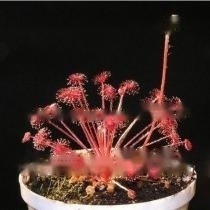
Chinese name: Peacock Sundew
Latin name: Drosera paradoxa
Kingdom: Plant Kingdom
Order:Purella
Family: Sundew family
Distribution area: Australia
1. Morphology of Peacock sundew
Peacock sundew It is a perennial herb with a stem vein height of thirty centimeters, woody, and two to four centimeters in diameter. Rhizomes are relatively short, with adventitious roots, with reduced leaves with root function in length, and bulbous bulbs at the ends, but not all plants have them. Leaves alternate or basal and densely rosette-like, covered with capitulum glandular hairs, young leaves often curled; stipules membranous, often fissured; leaves erect and gradually become parallel with age, petioles slender, about 2 -3 cm; insect-catching leaves are nearly round, 2.5-3 mm wide and 2-3 mm long. Cymes terminal or axillary, curved when young; flower stems 20-40 cm long, with pink or white flowers, 50-70 flowers per inflorescence.
2. Habits of Peacock sundew
Peacock sundew grows on the sandy ground along the river bank, the sandstone is covered with barren sandy soil, wet from March to April In season, the river floods and the habitat is submerged by the rapid currents; in the dry season, plants can be seen growing along the dry banks, and occasionally they can be found in the crevices of sand and gravel. Peacock sundew is distributed on the west and north shores of the Kimberley region, extending inland to Beverley Springs, Western Australia, east to Arnhem Land, and north to Kakadu National Park. The survival temperature of this species is 10-45°C, and the optimum temperature is 25-35°C. The ambient humidity is greater than 60%.
3. Planting of peacock sundew
During the planting of peacock sundew, water with low mineral content (such as rainwater, purified water, etc.) should be used for watering. Water supply at the bottom of the pot; avoid frequently spraying water on the plants to avoid the mucus on the glandular hairs being washed away; like strong light, the light will make the plants grow more robust, and the color is bright, and it can still be exposed to the sun in summer; if you need to fertilize, follow the instructions Spray more than 1/5 of the concentration.
Guess you like it
Cordyceps | Weeping sundew | Lean brokie | Nepenthes smiles | Nepenthes | Northern Territory sundew |
Charlson's bottle plant | African spirulina | Cape sundew | Dillowa |
Nepenthes Copeland | Nepenthes Corsican | Nepenthes Clos | Grass| Venus flytrap|
Nepenthes bigleaf| | Nepenthes campanula|
![[Dog Training 5] The training method of pet dog dining etiquette](/static/img/12192/12192_1.jpg)




